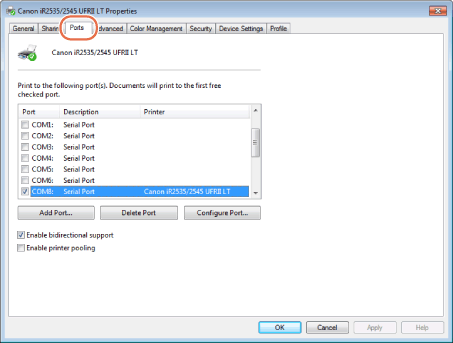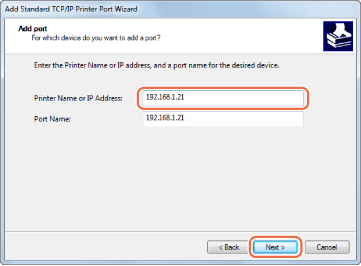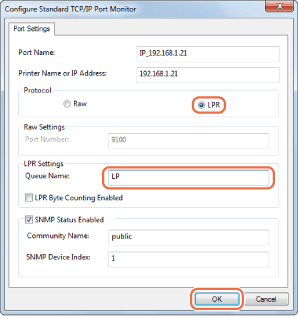Setting up a Computer for Printing / Sending a Fax
After you have completed the protocol settings for printing and sending a fax with the machine, you are ready to set up each of the computers for printing or sending a fax.
Connecting to a TCP/IP Network
All computers that use the machine must have TCP/IP client software installed and must be enabled for TCP/IP network use. For details, see the documentation provided with the operating system.
Installing the Driver and Specifying the Port Setting
To print or send a fax from a computer, you must install a driver and specify a port setting. The port setting differs depending on the application protocols used for printing or sending a fax. Use the information below as a guide to determine the application protocol you are using, and then perform the necessary operations.
LPD
LPD is a printing protocol generally used with TCP/IP.
See Printer Connection Method (LPD/Raw).
See Printer Connection Method (LPD/Raw).
Raw
Raw is a printing protocol used with Windows 2000/XP/Vista/7/Server 2003/Server 2008. It can print at higher speeds than LPD.
See Printer Connection Method (LPD/Raw).
See Printer Connection Method (LPD/Raw).
WSD
WSD is a protocol used with Windows Vista/7/Server 2008.
|
IMPORTANT
|
|
Sending faxes from a computer is available only when the optional Super G3 Fax Board-AG1 is attached to the machine.
To print or send a fax from a computer, you must be able to access the machine from the computer. Make sure that the IP Address Range Settings and Receiving MAC Address settings in TCP/IP Settings in Network Settings located in System Settings are set not to deny access from the computer. (Restricting Access from Computers on the Network)
|
|
NOTE
|
|
If Windows 2000/XP/Vista/7/Server 2003/Server 2008 or Mac OS X (10.4.9 or later) is on your network, you can set up a print server for more efficient management of network printers. Once a print server is set up, it can manage the print jobs. Also, by setting up a driver for the print server, the printer driver can be installed in each computer via the network.
|
Printer Connection Method (LPD/Raw)
The procedure described in this section is for specifying the port setting.
|
NOTE
|
|
If you are using Windows Vista, a dialog box may be displayed while you are performing the procedure. In this case, enter a user name and password. For more information, see the manuals provided with the operating system.
|
Installing a New Driver
Install the driver according to the procedures indicated below, found in the manual for each driver. For Macintosh, see the Mac Printer Driver Installation Guide.
If you want to use the UFRII LT/PCL/PS printer driver: See the installation procedures in the Printer Driver Installation Guide. (See Chapter 3, “Accompanying CD-ROMs,” in the User’s Guide.)
If you want to use the fax driver: See the installation procedures in the Fax Driver Installation Guide. (See Chapter 3, “Accompanying CD-ROMs,” in the User’s Guide.)
|
NOTE
|
|
On Windows, the default printing protocol will be Raw if the driver has been installed according to the Printer Driver Installation Guide. If you wish to use LPD as the printing protocol, change the settings after the driver is installed. For details, see Changing the Port after Installing the Driver.
|
Changing the Port after Installing the Driver
|
NOTE
|
|
For Macintosh, change the network configurations of your printer in the [Print & Fax] setting in [System Preferences]. See the Mac Printer Driver Installation Guide.
|
1
Open the printer properties dialog box.
For Windows 2000
|
1
|
Click on the [Start] menu → point to [Settings] → click [Printers].
|
For Windows XP Professional/Server 2003
|
1
|
Click on the [Start] menu → [Printers and Faxes].
|
Windows XP Home Edition
|
1
|
Click on the [Start] menu → point to [Control Panel] → [Printers and Other Hardware] → click [Printers and Faxes].
|
Windows Vista/Server 2008
|
1
|
Click on the [Start] menu → [Control Panel] → [Hardware and Sound] → [Printers].
|
Windows 7/Server 2008 R2
|
1
|
Click on the [Start] menu → [Devices and Printers].
|
2
Right-click the icon of the printer you installed → click [Printer properties] ([Properties] for Windows 2000/XP/Vista/Server 2003/Server 2008).
3
Click the [Ports] tab to display the [Ports] sheet.
For Windows 7

4
Click [Add Port] to open the [Printer Ports] dialog box.
5
From [Available ports types], select [Standard TCP/IP Port] → click [New Port].
The Add Standard TCP/IP Printer Port Wizard starts.
6
Click [Next].
7
In [Printer Name or IP Address], enter the printer IP address or printer host name → click [Next].
For Windows 7

8
After the computer has confirmed that there is a printer to which the entered IP address is assigned, the [Completing the Add Standard TCP/IP Printer Port Wizard] window appears → click [Finish].
If the dialog box displays <Additional Port Information Required>, follow the instructions on the screen to search again, or click [Standard] → click [Canon Network Printing Device with P9100] under [Device type] → click [Next] to exit the Wizard.
9
Click [Close] to close the [Printer Ports] dialog box.
If you want to use LPD:
|
1
|
Proceed to step 10.
|
If you want to use Raw:
|
1
|
Proceed to step 11.
|
10
If you want to use LPD, change the port configuration information.
|
1
|
In the printer properties dialog box, click [Configure Port].
|
|
2
|
Click [LPR] under [Protocol] → enter a print queue name in [Queue Name] under [LPR Settings] → click [OK].
For Windows 7
 |
The machine prints according to its spool settings.
11
Click [OK].